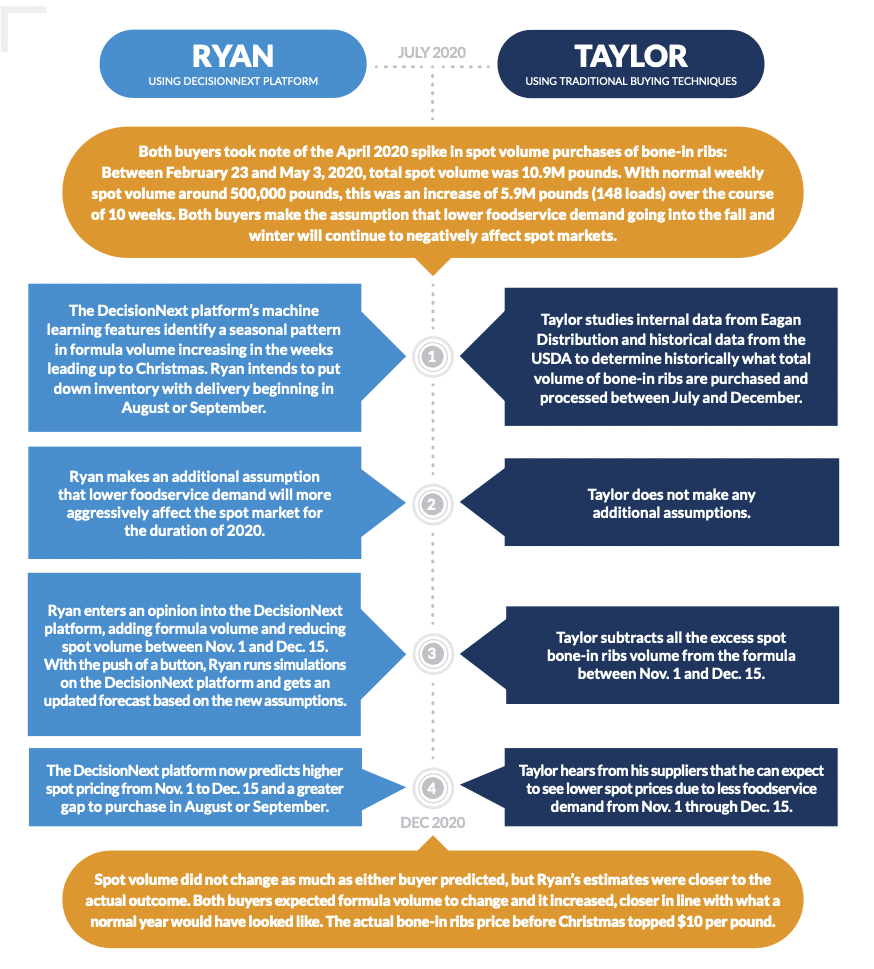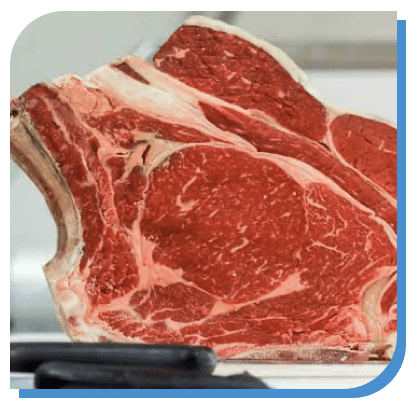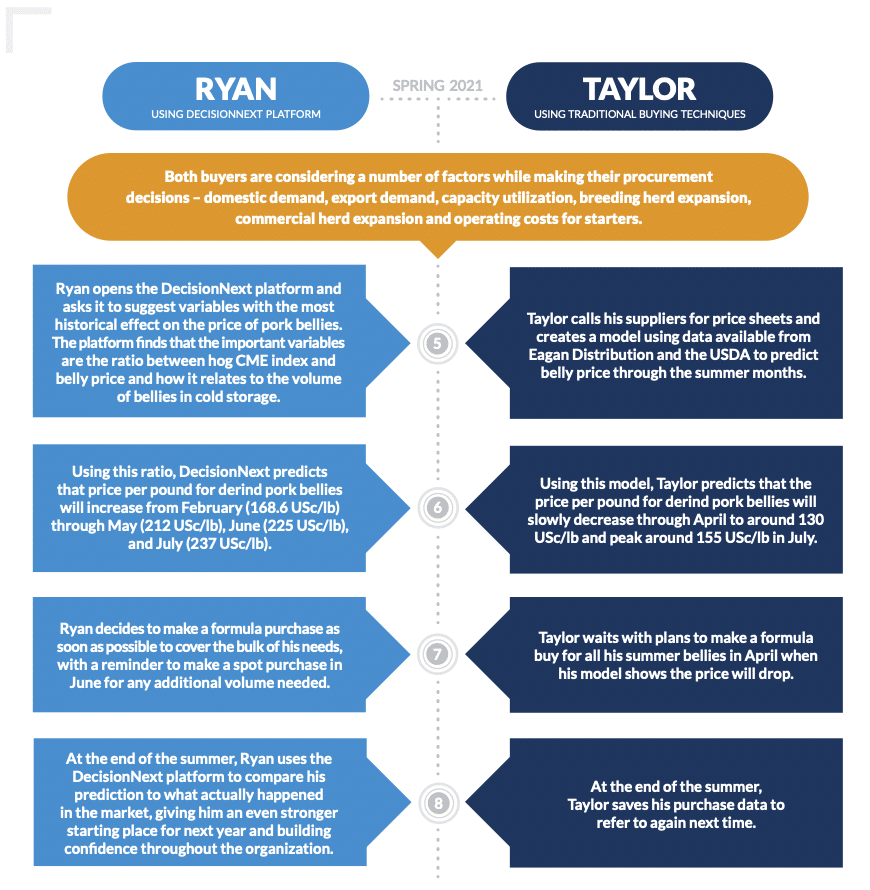Let’s Set The Stage:
It’s July 2020 and Ryan from Meat Street Grocery and Taylor from Eagan Distribution are running their buying desks from home due to COVID-19. Because of the pandemic, Ryan and Taylor are both getting started early to ensure there are enough bone-in ribs on hand for one of the most important times of the year – Christmas. Buying early increases the risk that the market will move, putting both buyers in an uncomfortable position, but waiting too long increases the risk that the products may be unavailable. Plant closures, foodservice shutdowns, consumer behavioral changes and production line slowdowns only compound the risk.
As Ryan and Taylor work on their predictions so they can make their buys, they have much more to consider than in a “normal” year:
- Will demand for meat still be sky-high come the holiday season?
- Will markets follow their traditional trends or are we in a different world now?
- Will processing plants continue the close and reopen cycle through the summer?
- Will Christmas actually happen at all?
Let’s break down how each buyer approached purchasing bone-in ribs.

Based on their assumptions and purchases, Taylor found himself scrambling in early December to find more bone-in ribs to send to retail. Taylor also ended up costing Eagan Distribution $2 per pound. Ryan, however, anticipated the demand switch and was ready to act when prices were more favorable.
Black swan events like COVID-19 can’t be predicted. But they’re significantly easier to manage when combining industry experience with prescriptive analytics.
Evolve Your Forecasting and Decision-Making Skills With DecisionNext
Designed to help commodity-focused industries such as food, meat, agriculture and their related customers, DecisionNext lets users simulate market conditions to quickly create risk-aware forecasts. Designed to support both the buying and selling side of the protein industry, the platform combines machine learning with human expertise, allowing users to modify forecasts by entering opinions into scenarios, for example. With this, DecisionNext mitigates some of the risk that comes with buying and selling a commodity with an expiration date.
Animal agriculture has existed longer than industry itself and has seen evolution after evolution in that time. In the U.S., Chicago was the meatpacking capital until the 1920s. Compact multistory buildings allowed for a pseudo-assembly line for harvest. At that time, refrigerated rail cars were just beginning to come online and carcasses could be shipped anywhere with a rail line.
Meatpacking began moving out of Chicago and closer to where animals were being raised. The new harvest facilities were sprawling one-story buildings with technological upgrades that included power saws and a Henry Ford-style assembly line. Another innovation came in the 1960s from Iowa Beef Packers – boxed beef. Instead of shipping whole carcasses for disassembly upon arrival, packers could now sell boxes full of a single cut from multiple animals. This allowed buyers for the first time, to choose the selection of cuts they wanted, rather than simply a volume of beef.
Today, we are seeing a movement away from boxed beef toward case ready meat products. These products come pre-cut and weighed in vacuum-sealed packages that can be immediately put on meat case shelves for shoppers.
All the while, meat purchasing was also trying to keep pace. The industry had to adapt to technological advances – like when the USDA started sharing weekly harvest data updates on the internet. Overnight, technology savvy meat buyers had a leg up because some of the data they relied on to make purchases was available instantly and at their fingertips.
Another evolution is happening today as decision makers shift toward significant use of technology and artificial intelligence. While artificial intelligence may still sound like technology of the future, it is very real now. Siri and Alexa use machine-learning technology to understand natural language questions and requests. Tesla uses artificial intelligence for self-driving and predictive capabilities. Even platforms like Netflix, Pandora and Spotify® are using the technology to serve users content suggestions that will keep them tuning in for more.

How, though, does this artificial intelligence and machine learning intersect with the buying and selling of meat or other commodities? The DecisionNext platform uses machine learning to learn from its mistakes. The platform makes a prediction based on available data and, optionally, user input, which it can then compare to actual performance numbers. Back-testing provides users with a more accurate performance model.
One challenge facing packer-processors right now is the changing of the guard in positions like meat buying. In 2020, more than 30% of professionals in the industry were Millennials and younger.1 As the current generation of buyers retire, institutional knowledge is retiring with them. However, the younger generation’s interest in data and technology may serve them well as they adapt to using analytics software like DecisionNext to help inform their buying decisions. Along with bringing rookie buyers up to speed faster, analytics can also leverage procurement veterans’ market knowledge to level up less experienced team members and help the entire company evolve.
Make More Science-Based Decisions With Data Analytics
Data analytics is, most simply, the process of analyzing data. The goal of this is most often to discover new insights, help inform conclusions and support in decision making. In business, data analytics helps make decisions more science-based, adding confidence to your buying team’s decisions.
The DecisionNext platform provides prescriptive, risk-aware analytics based on machine learning artificial intelligence, plus expert insight. Prescriptive and predictive analytics are often confused, but they are not the same. Predictive analytics turns data into a prediction or forward-view of what is going to happen. Prescriptive analytics layers in a decision-making model to make a recommendation about a specific decision, like when to buy those ribs.
So, in the earlier example of Ryan and Taylor buying bone-in ribs for the holidays, the DecisionNext platform predicted that the price of ribs would increase in the weeks immediately before the Christmas holidays because of the increase in spot purchases earlier in the year. Ryan and Taylor had to decide to either position short and wait for the dip to buy or only buy on formula and not at a fixed price.
Using the DecisionNext platform, Ryan made educated and calculated assumptions. They were also reviewable, explainable and measurable assumptions that could be improved on the model going forward. Taylor, on the other hand, made historical behavior-based assumptions. These are more difficult to look back on to explain why, measure how he did or improve upon in the future.
Check In Time
It’s now spring 2021 – the year of great uncertainty is over and our meat buyers are preparing their pork belly buys for summertime bacon. This time, in addition to lingering COVID concerns, they are also considering African Swine Fever and the new administration’s effect on pork exports. They are also having to still consider whether the restaurant industry’s use of pork bellies will be rebounding to pre-2020 levels.

Combine Your Industry Expertise With Our Machine Learning Platform to Make Your Next Decision With Confidence
As we can see from these scenarios, countless variables go into each decision meat buyers make. While decisions are often made over pennies on the pound, those pennies can quickly become hundreds of thousands of dollars or more. DecisionNext helps keep those pennies in your pocket by combining your industry expertise with up-to-date data and machine learning capabilities. Whether you’re buying livestock for harvesting, selling subprimals for further processing or planning summer promos for retail, the DecisionNext platform can help you make your next decision more confidently.









